You are currently browsing the variant covers category
So I’ve written about publishers test-marketing variations on their comics before, specifically when DC tried out more kid-friendly covers on a couple of their titles. I experienced those (well, at least one of those) in the wild, in real time as it happened, so I have a little more direct understanding of what was happening there (even if I had some initial confusion over “whoa, Firestorm looks different this month).
Some of the 1970s test-marketing, however, I only really experienced in the secondary market, during my extensive tenure at the previous place of employment. At some point, we began to realize that there was an increase in demand for some price variations of certain 1970s Marvel books. In particular, the 35-cent covers on comics that were at the time normally 30 cents. As an example (using scans borrowed from the immensely useful resource, the Grand Comics Database), this issue of 2001: A Space Odyssey #7, cover-dated June 1977.
First off, the widely available 30 cent cover, as acquired by the hoi polloi:
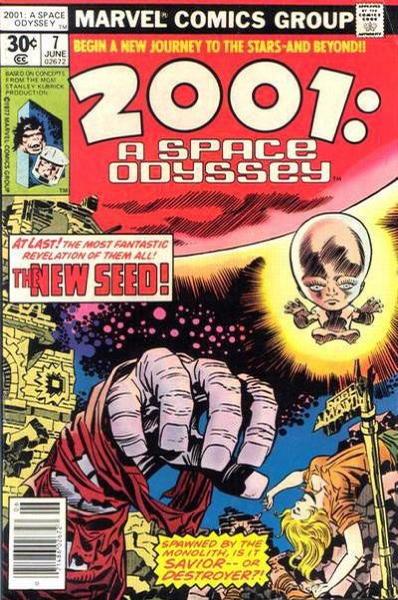
And the 35-cent variant, obtained off the newsstands by a few select elite for whom we must all show reverence:
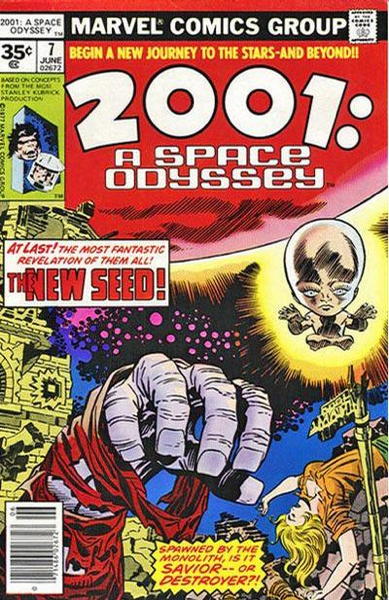
And apparently there’s a British price variation, too, but I’ll get to those some other day if I have anything to say about them aside from a “look at that weird space money they’re charging on those covers” take:
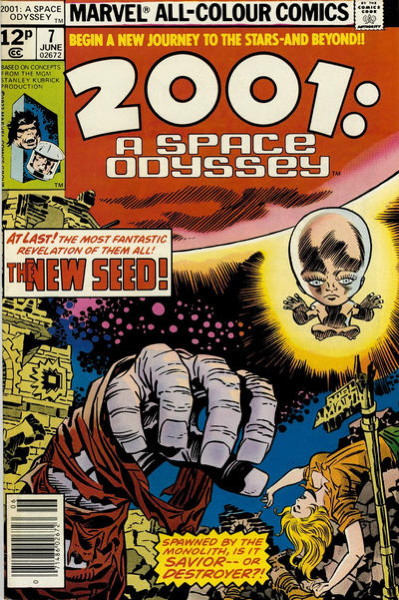
I was trying to pin down exactly when we realized “hold on, people are spending crazy money on these,” thus spurring us on to scour the many, many “end-of-Raiders-of-the-Lost-Ark-esque” boxes in our backroom looking for them. I want to say it coincided with our late-1990s move to eBay, where it was easier to see as it was happening countrywide, and worldwide, trends in comic collecting demand. And I feel like there was also an uptick in customers dropping by and specifically asking for those 35-centers as well.
I did a little research (okay, I Googled) and as it turns out, an Overstreet adviser was catching on and starting spreading the word about these variations. This would jibe with my memory of when we started experiencing increased demand for them. Now I’m sure folks running comic shops and tabling at conventions must have noticed when they had copies of an issue of something-or-other and each had two different prices, but it took this enterprising person to catalog just how widespread this was. And once word got out and it made it into Overstreet, well, that was that.
Now this test-marketing went on for a few months in 1977 (and including Star Wars #1, which is almost an entire variant cover-age article in its own right). The previous year, however, also saw some test-marketing from Marvel on price points, by trying out 30-cent prices on their 25-cent comic line. Behold Howard the Duck #3 (May 1976), first in its 25 cent configuration:
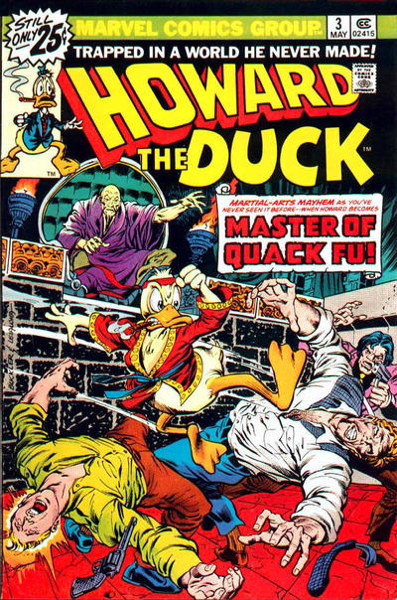
…and then in its shocking 30 cent glory:
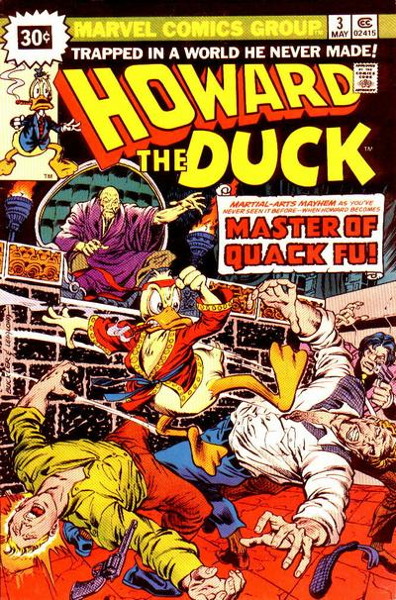
(A hint to any readers from decades ago seeing my site with their future-scopes: once a comic starts saying “Still Only” in front of their prices, get ready for that price to go up.)
Now this website actually identifies the six areas where these higher priced books were distributed (c’mon, Boston, you can afford that extra nickel!). One of those spots was San Jose, CA, which is relatively close-ish, so I’m sure at the old job we must have at least some of these variations come through. I don’t remember anyone making a particularly big deal out of those at any point, not like with the 35 cent comics, but the latter certainly had a lot more publicity at the time.
It’s weird to think of a period of time where comic book companies would go through that much effort to discover how much kids would balk at dropping a few extra cents on their funnybooks. (And as my former boss Ralph reminded me the other day, Dell Comics did it too, and I’m sure they weren’t the only ones.) Of course, comics had much larger readerships then, and wider distribution in general marketplaces, rather than being restricted to a small-ish number of specialty shops today that only cover a portion of the sales areas comics used to reach. Now it feels like the test-marketing of prices is just done to everyone at once, with Marvel and DC seeing how many $4.99 and $5.99 and $9.99 books their print audiences will tolerate.
John asked
“What about Superman The Man of Steel #30, the vinyl cling/’colorform[®]’ cover. Would that make it the ultimate variant cover? Apologies if this has already been mentioned. I’ve been following the site and haven’t seen it. Keep up the great work!”
Ah, yes, what about Superman: The Man of Steel #30 indeed? Let us take a gander at this comic, cover dated February 1994, released December 1993:
Here is the front of the “collector’s edition,” sealed in a polybag:
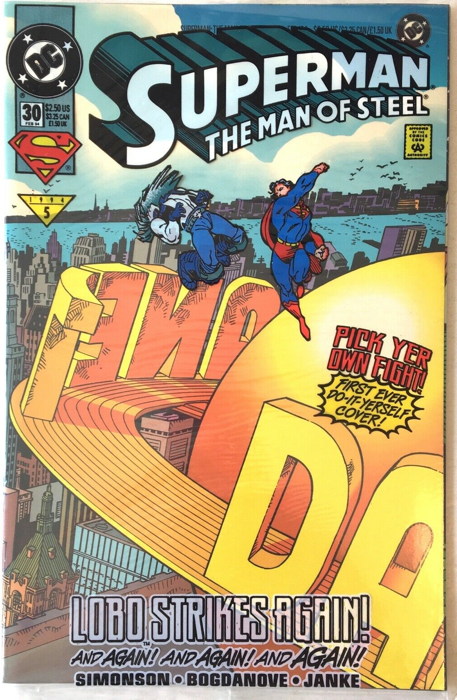
The back cover, showing the Colorforms® er, “vinyl clings” that John mentioned:
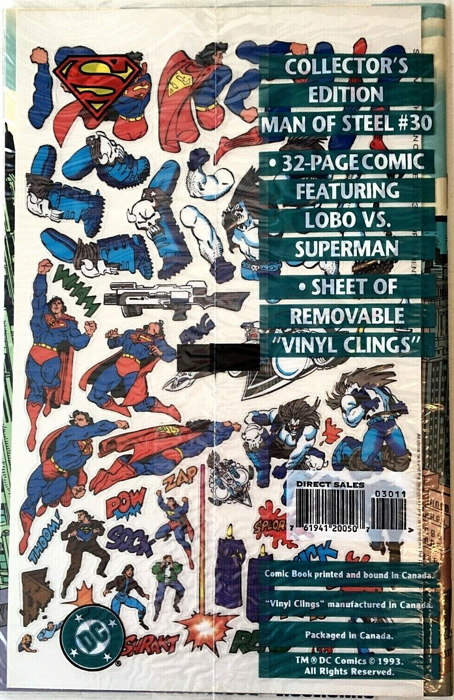
Here’s a better look at them, without the printing on the polybag:
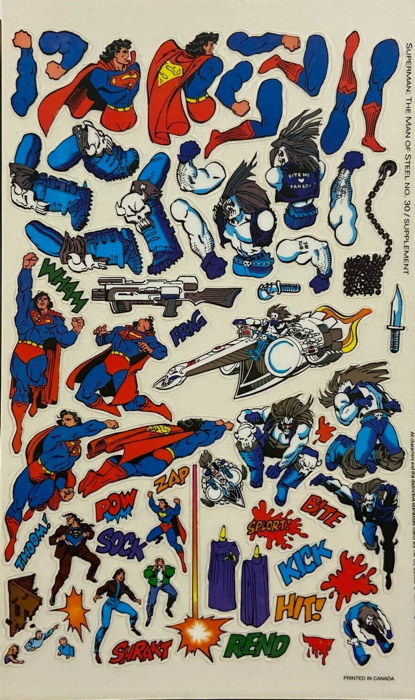
And here’s what the cover looks like out of the polybag, front:
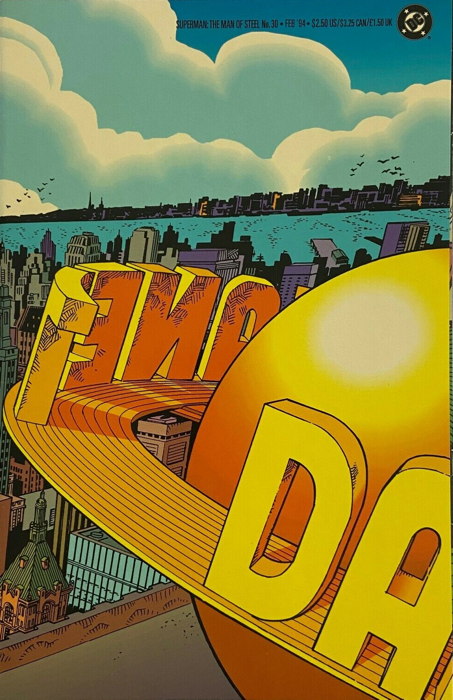
And back:
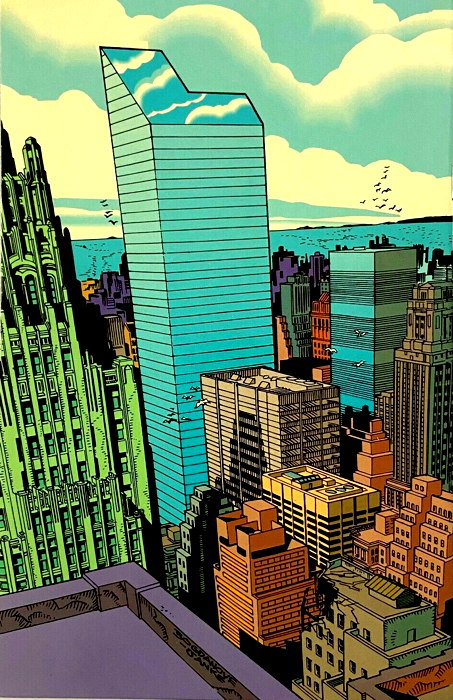
And for comparison, here is the “regular” edition of the issue, AKA the “newsstand” edition (though pictured is the one sold through comic shops, as per the “direct sales” tag in the UPC):
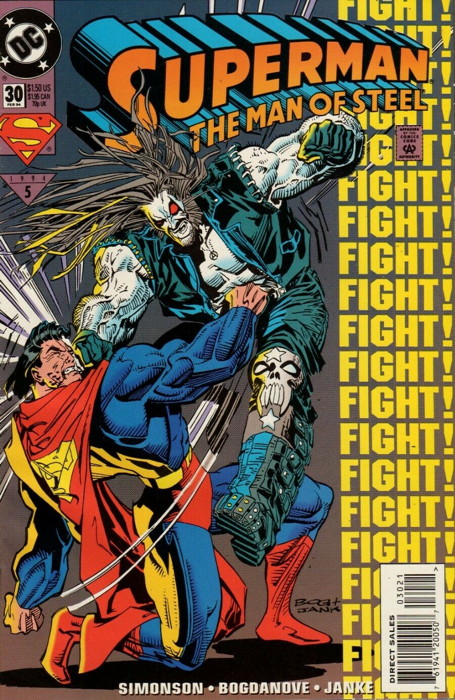
Now I just totally stole all these images from the eBays, because 1) my own copy of the collector’s edition, still with the polybag (neatly trimmed open along the top so I could pull it out and read it) and clings, is currently inaccessible due to some current house rearranging-type stuff, and 2) I don’t currently have a working scanner at home and haven’t quite made the time, or loosened up the cash, to get a new one, so, hence, the liberating of scans from elsewhere.
And as John noted…the Collector’s Edition sort of is the Ultimate Variant Cover, as you make whatever design you want affixing your clings however you’d like, removing them and moving them around. If you’re not familiar with Colorforms® and similar toys, these aren’t stickers as such, but rather, as we keep saying, “vinyl clings” (hey, don’t blame me, the quotation marks are on the packaging) that are reusable and can stick to the slick, thick cover of the comic, then peel ’em off and move ’em around as you see fit. And when you lay the comic flat and opened, you get that nice shot of Metropolis on that wraparound cover by Jon Bogdanove and Dennis Janke, which makes for a nice playfield for your clings.
It’s a very clever gimmick…and yes, we’re straddling the line between “gimmick cover” and “variant cover” here, but the gimmick is a “Do-It-Yerself” cover as noted on the polybag, so I think we’re…er, covered. Now, I was going to say this was a unique gimmick, as I couldn’t recall anyone attempting such a weird thing again, However, a quick Googling reveals that writin’-about-funnybooks pal Brian Cronin just talked about this very comic only a few months ago, so, um, oops, sorry Brian, hope I’m not stepping on any virtual toes here. But he noted that DC itself repeated the gimmick for the Worlds Collide Milestone/DC crossover event which I didn’t remember (I mean, I remembered the crossover, not the clings). Anyway, read Brian’s article as he goes deeper into the history of Colorforms® and the reasons why gimmick covers such as this were so prevalent in the ’90s.
I remember this selling pretty well for us at the time…Superman sales were still pretty strong post-Death of, even in those ’90s crash days. But this particular edition with the clings was just odd enough to attract extra attention, and it continued to be a good back issue seller for years afterwards. Even now, when I get a copy in, it tends to go out again in relatively short order. I’m not even sure if I have one in stock right now.
What’s great is that, as I recall, the slick cover stock used for Man of Steel #30 is identical, or close enough, to the “cardstock variants” DC is currently burdening offering on nearly all of their current releases. Thus, imagine having this Lobo cling:
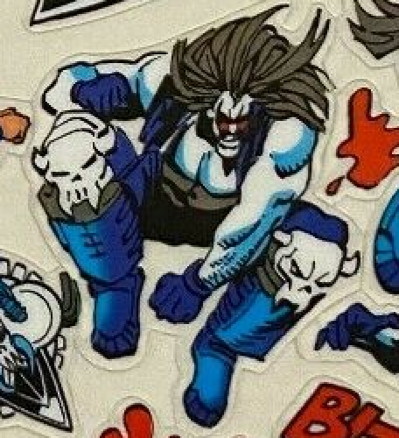
…just leaping in on, oh, say, this cover:
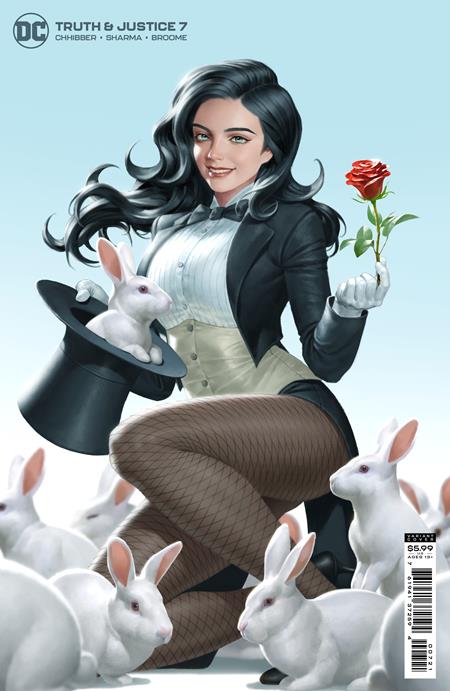
Or God help us, this:
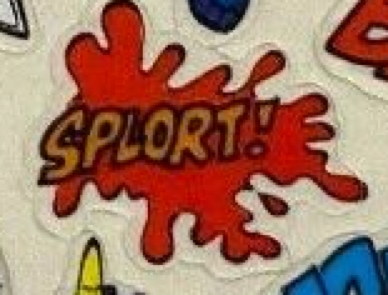
being used on this:
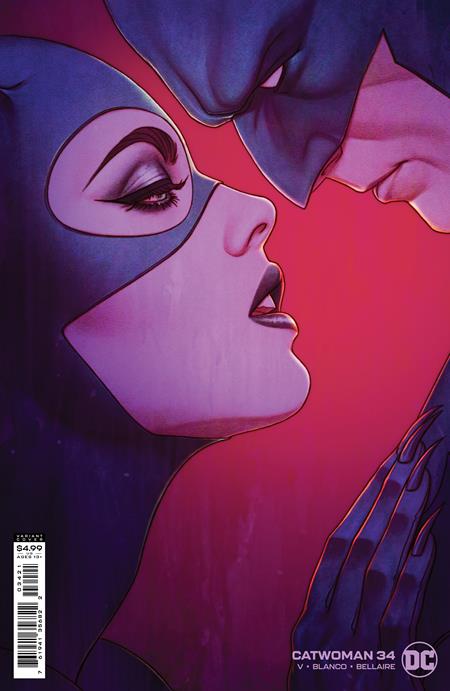
The possibilities are endless. Everything (or at least everything with the proper paper type as a cover) is a variant now. I HOPE YOU’RE HAPPY, JOHN.
Now, my secret shame: I never played with the clings on my own copy of Man of Steel #30. Not sure why…not like I’m planning on reselling any of my Superman comics, no reason to worry if everything’s in “mint” or not. And I’ve played with this sort of toy as a kid…I was the proud owner of the 1974 Evel Knievel Colorforms® set, after all:
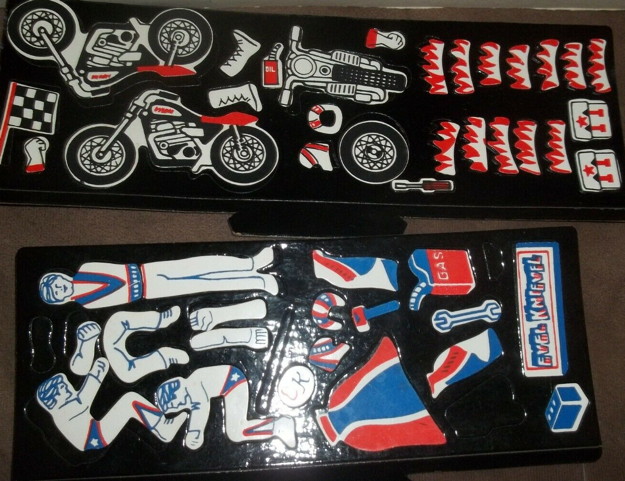
…and I do still have my Swamp Thing Presto Magix Totally Not Colorforms® set. Hey, that’s an idea…Evel and Lobo racing their respective cycles while Superman goes toe to toe with Arcane and his Un-Men, all over the streets of Metropolis! Okay, now I have good reason to regain access to my Superman boxes and dig out that issue! GREATEST SUPERHERO BATTLE EVER, HERE WE COME.
Blogging is still (mostly) on hold for just a bit longer, while my evening blogging time is occupied by other responsibilities. I should be up and running again later this week, so thank you for your patience!
In the meantime, in talking with former boss Ralph, while specifically discussing my variant cover-age series, he mentioned a couple of other comics that I didn’t realize had variant covers, so I’ll be looking into those for a future post or two.
Also, I asked Ralph about his orders on Deadworld, as in my post discussing that title I presumed we probably ordered more of the “gory” cover versus the “tame” cover. It’s Ralph’s recollection that while he ordered fairly heavily on the earlier issues, farther down the line he was only ordering a very few for the rack, and he’s pretty sure he was getting equal numbers of each version. Now overall, I still guess the printrun was maybe a little larger on the gross cover versus the not-so-gross cover, but at my previous place of employment, at least in the latter days of that title, that may not have been the case.
Okay, that’s it for now, I should be back in action by Friday…or maybe even Wednesday, if things work out. Thanks for reading, pals, and I’ll be yapping at you again soon.
So I picked up a collection the other day, where the fella selling prefaced his offering with “they’re all from the early ’90s.” I replied “well, don’t get your hopes up, I probably won’t need much,” and then I proceeded to purchase everything he had as I indeed did “need much.” Nothing super-spectacular, just lots of X-Men and Spider-Man stuff, other Marvels of the period I could use…lots of books that aren’t jumping out of those “key collecting” apps everyone’s got their noses stuck to, but remain consistent sellers.
Many of the comics in this collection were “newsstand” editions, with the standard UPC codes. As noted before, there seems to be increased collector interest in newsstand editions, as they’re seen as “rare variants” and the like, in a market newly desperate for readily available “collectibles.”
And thus, yes, I’m bumping up prices on some of the newsstand books I acquired…hey, baby needs formula, don’t look at me like that. But of particular note in this collection was a comic I’d never actually seen before in its newsstand form, 1994’s Spawn-Batman:
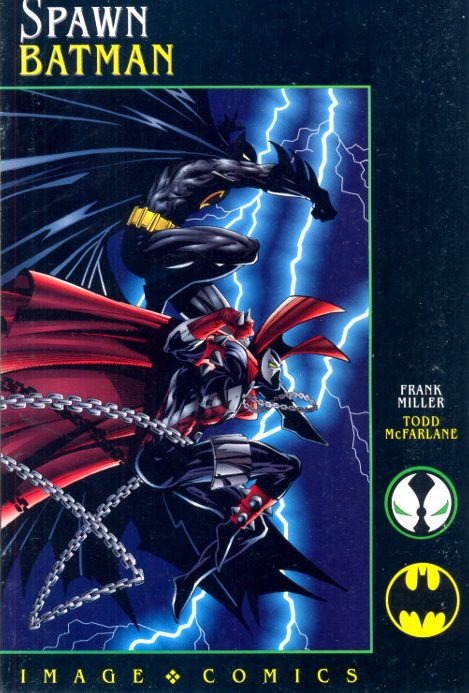
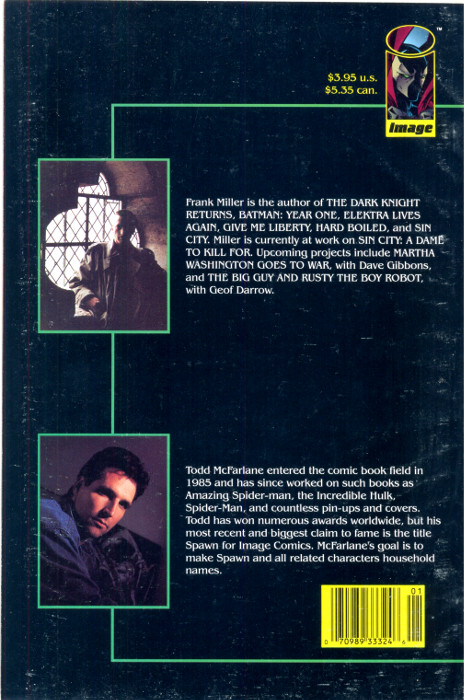
Aside from the UPC code on the back, the primary difference is that instead of the stiff covers of the direct market version, it has floppy paper covers, as seen in this Instagram video I made. (And if you think I’m being too rough on it in that clip…it ain’t high grade, it can take a little manhandling.)
Pricing the book was a bit of a bear…I don’t believe it’s in the current price guide (at least, it’s not in the two-year-old guide I have at home), and online prices are all over the map. Some eBay sellers had it in the $5 to $10 range, which seemed too cheap, and on mail order house had a midrange copy for hundreds of dollars, which seemed miles too high. I ultimately skewed lower-end, assuming a mint copy to be ~$20 and working it out from there. Sometimes…you just gotta make stuff up.
Also in the collection was a newsstand edition of an Image book I did know about…in fact, I’d seen it racked in a downtown newsstand back when it was new: WildC.A.T.s #2:
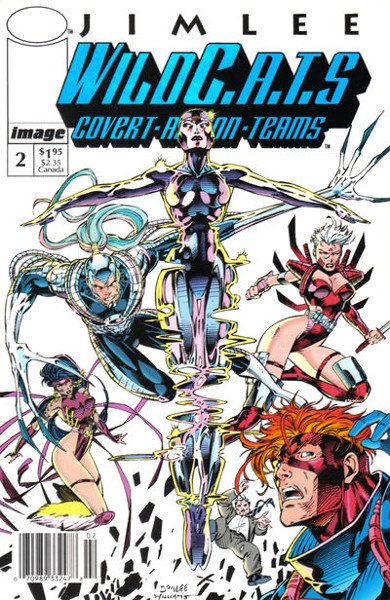
The all-white background on regular paper made it stand out, given that the direct sales edition I was used to was the stiff-covered, foil-enhanced version:
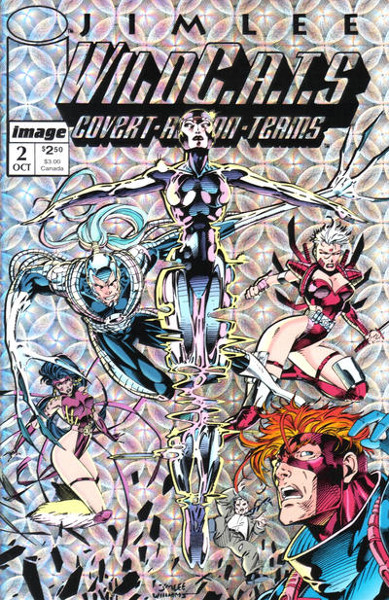
There were two copies of this one in the collection, in beautiful NM shape, both of which ended up selling to the same fella for $15 a pop. Again, a price I researched and ultimately had to work out on my own.
There were also lots of just plain ol’ Spawn in the UPC-burdened newsstand flavor:
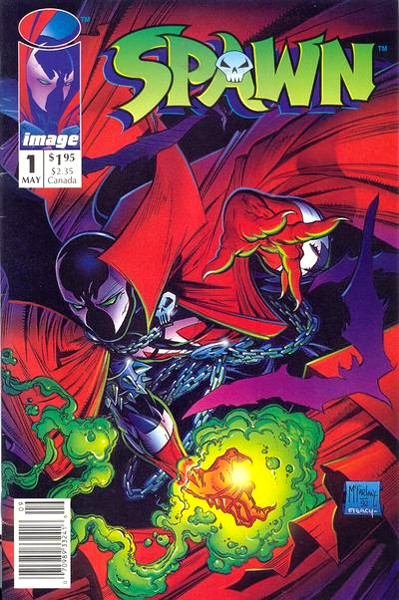
…not the #1 pictured here, alas, but scattered issues running from about 2 to 27. I seem to recall seeing a few Spawns on newsstand racks at the time, too.
Now I don’t know how long this newsstand push of Image’s lasted. On the Grand Comic Database, the latest newsstand Spawn they had was #134 from 2004. That’s far later than I expected, though after about #52 GCD only shows a handful of newsstand Spawns here and there. I presume those editions do exist, as it seems like a lot of trouble to only sporadically distribute your issues through certain venues.
Another Image title, Savage Dragon, had newsstand editions listed up through 26 in 1996. No idea if there are more after that…didn’t spot any in an eBay search, though I did spot lots of other Image books I didn’t suspect would have had newsstand distribution: Savage Dragon Vs. Savage Megaton Man anybody? Plus, I imagine recent issues of Savage Dragon would be quite the trick to rack in a convenience store, given the uptick in “special hugging” the book’s seen of late.
These are…interesting novelties, I think, and, especially in Spawn‘s case, published for much longer than I realized. I figured for sure the newsstand distribution was an early artifact of Image’s launch, but nope, there’s that 2004 newsstand issue of Spawn. And yes, I bumped up the prices on these Spawns I picked up in the collection, too..a little extra percentage over the guide. Yeah, I know, what can I tell you…I’m part of the problem.
So y’all remember my last variant cover-age post? You know, the one way back when? Well, in response to that, Sam T Goostree noted
“Deadworld used to have tame and gory covers if I recall.”
Sam T Goostree, that “T” must stand for “Truth” because you just dropped some on us. Deadworld was sort of The Walking Dead of its day, an extended humans vs. zombies narrative in funnybook form that began at Arrow Comics in 1986 during the black and white boom, continued on at Caliber Comics, and is still being reprinted today in new paperback volumes.
It was during the Arrow run that the split covers began to be offered. From what I can see on the Grand Comic Database, #5 in 1987 was the first, with the “tame” cover appearing as so:
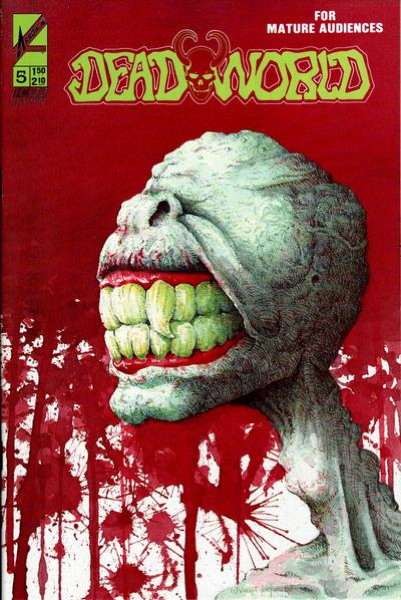
…and the graphic cover, if you want to see it, linked here. (WARNING: image features blood, guts, and veins in teeth.)
This continued through the end of the Caliber run in 1993. Caliber relaunched Deadworld with a new #1 that same year, and more series, including some IDW minis, would continue to pop up through the 2000s. However, while there were variants here and there, it doesn’t appear the “graphic” and “tame” distinctions carried on. Most of the later covers appear to lean more “tame” than “graphic,” at least as far as I saw.
Anyway, if you want to see more of the “grahic vs. tame” imagery that appeared on these comics, the Grand Comic Database has cover galleries for the Arrow and the Caliber portions of that series.
I’m trying to dredge up any recollections of the series and its sales, given that the initial run mostly overlapped with my beginnings in comics retail. My presumption is that the “graphic” cover sold better, or at least was ordered in higher quantities, than the “tame” cover, and I don’t recall taking any special precautions to make sure the “graphic” cover wasn’t displayed in a way to offend those of a delicate demeanor. Honestly, I don’t think we had to, as the racks we had at the time would overlap the covers and thus obscure most of the horror. My only specific memory was a coworker pointing out this cover:
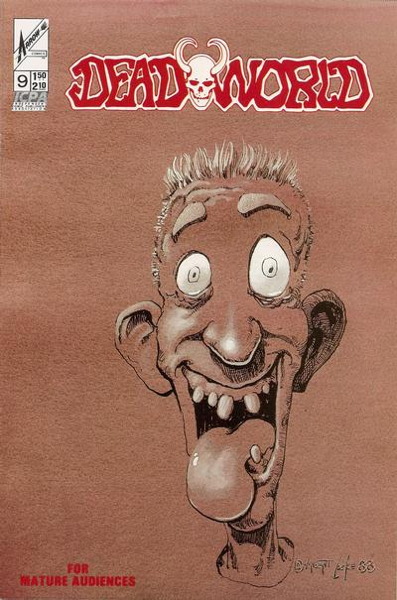
…and being somewhat disdainful of it for some reason. Not sure why she didn’t like it…I thought it was a funny image, though to this day I have no idea how it ties into what I presume is the serious and violent story it’s telling. I’ve not read a single page of this comic…not a moral or critical judgement, I just can’t read everything…but that cover sure came close to getting me to pick it up solely to figure out “what’s going on here, exactly?” Which, of course, is the goal of any cover.
The option of letting the reader decide if s/he wanted a full on gory image or a relatively innocuous one on the cover that s/he took home was an interesting gimmick (and one that likely encouraged some double-dipping by at least a handful of completists who bought both), which reminded me of something else.
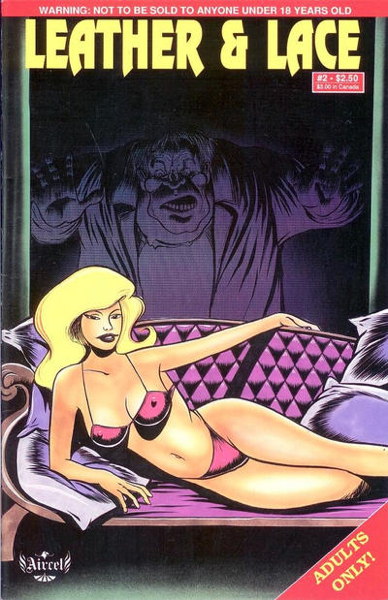
Aircel’s Leather and Lace by the late Barry Blair was an “adult” comic book, which meant sex scenes interspersed among what was presumably something resembling a story. Howard Chaykin’s Black Kiss, another dirty filthy dirty comic, had a great deal of success the year before Leather and Lace‘s debut in 1989, and that each issue came out sealed in a polybag was an attention grabber. As such, Leather and Lace was also factory sealed in polybags, a little larger and looser than the comparatively tight-fitting ones on Black Kiss, to help get even more attention on the rack (on purpose or not).
The deal with this series was that, to accommodate Blair’s “younger fans” (as the reasoning went, if I’m recalling correctly), this Adults Only comic would also come in an General Audiences version:
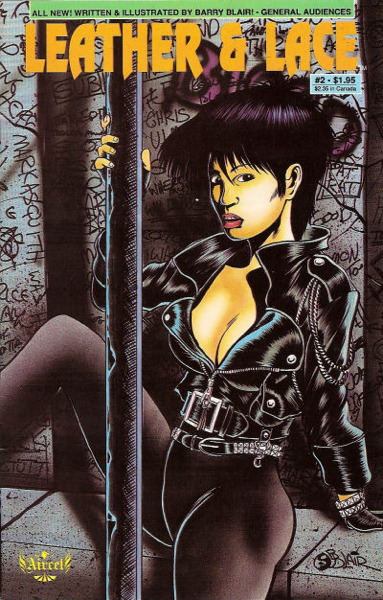
…with all the naughty bits excised out. I believe there were some replacement story pages or such…I mean, there would have had to be, right? At any rate, we’re not only getting variant covers on each issue, but the dreaded variant interiors as well. It brings to mind a Robert Smigel skit for TV Funhouse, the name of which I’d rather not repeat here for search engine reasons, in which a pornographic film is reedited for an all-ages audience, and it becomes just two people briefly speaking in a room before the credits roll.
Presumably the younger fans didn’t show up in droves for the version of Leather and Lace made especially for them, as the General Audiences editions were dropped after eight issues. And to be frank…the covers on the “general” versions weren’t much less adult than the “adult” versions, sometimes, and neither were the interiors. Even with the sex scenes excised, there was still a…salaciousness about it that made us not want to sell that version to non-adults. Not that we had to worry, because I don’t think anyone who wasn’t an adult expressed any interest in it.
Okay, the comparison between Deadworld and Leather and Lace is slight (and possibly never made before), but each series giving you an option of either an extreme visual or a supposedly more staid one was the tiniest thread that connected the two in my mind. Certainly not that I was writing to each company asking for a crossover of the two. Nope, certainly not, never did it.
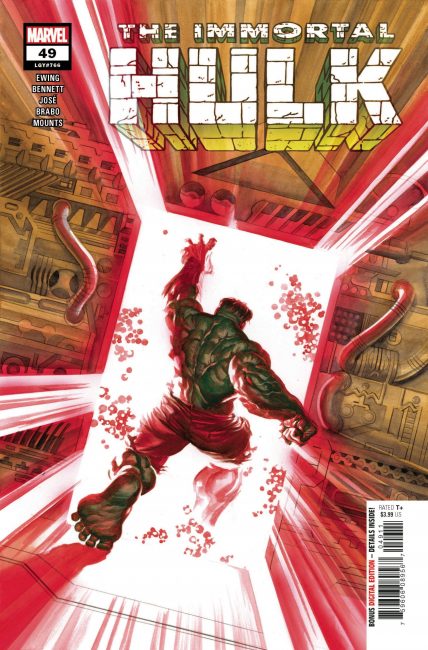
It’s a Special Album Issue, just like the good old days! Full-page illustrations combined with prose appearing in your otherwise regular Marvel funnybook…not a thing I’d like to see on a regular basis, but okay once in a while, especially if done well, like it is here, taking what could have been yet another Hulk-versus-heroes battle and applying some of the book’s usual levels of gravitas. One thing I liked is the opening (and continuing) comparisions between Bruce Banner and the Hulk with the Fantastic Four.
In an interesting confluence of events, Adam Warren, in his notes to Tuesday’s serialized page of Empowered, says
“…This does seem to represent a bit of a lost opportunity for superhero storytelling—that is, conveying how BLUDGEONING AND EARPIERCINGLY G-D LOUD that most cape-related conflict would be. Of course, the use of giant frickin’ sound FX and the like would burn up pagecount in a hurry, but this still seems like a narrative avenue worth exploring on occasion….”
And this issue of Immortal Hulk does just that, emphasizing the sounds of conflict, the drowned-out voices, et cetera…and given the illustrated text format of the issue, it manages to get around the sound effects problem that Warren posited. Thought that was a nice coincidence!
• • •
Joe
mentions, like I probably should have in Monday’s post, that the double-covered #2s had been a prominent feature during the “Heroes Reborn” year-long experiment with the Image Comics artists. Not just on the Reborn books, but on new title launches like
Thunderbolts (which I remembered) and he also mentions
Deadpool, which I didn’t remember and can’t find that it had a second cover (beyond having a newsstand “variant” with the standard UPC…am I missing something? Wouldn’t surprise me! ). Anyway, I should have noted when the two covers for the second issue started, and thank you Joe for stepping in.
Matthew asks
“Years ago I remember reading that for some period of time the second issue of the GI Joe series that Marvel put out was actually more valuable than the first issue because there were so many fewer issues printed. Was that ever true? Is it still true?”
Other commenters provided their answers, but I thought I’d answer here, too. Yes, there was a time when the second issue of Marvel’s G.I. Joe: A Real American Hero was commanding higher prices than the first.
Now I’m just working off my memories instead of, you know, doing research, but I believe the common belief was, true or not, that the second issue had a smaller print run that the first. And given that G.I. Joe was a relatively popular commodity at the time, it wouldn’t surprise me to find out that the first issue was in higher demand than expected, and retailers lowering the order on the second issue (without yet knowing how #1 would be received) resulted in the higher demand and comparative scarcity.
Contributing to this disparity in cover prices. Issue #1 was extra-sized and printed on nicer paper, selling at $1.50:
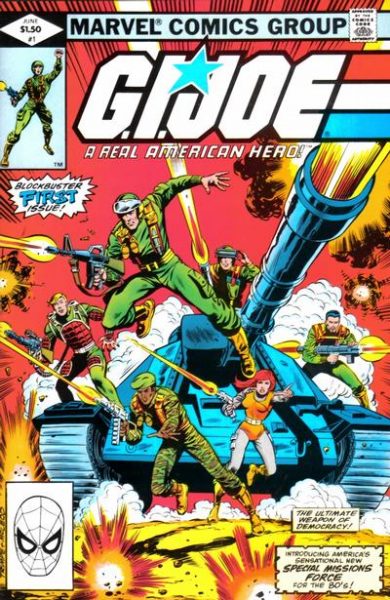
…and then #2 was the standard format comic at 60 cents:
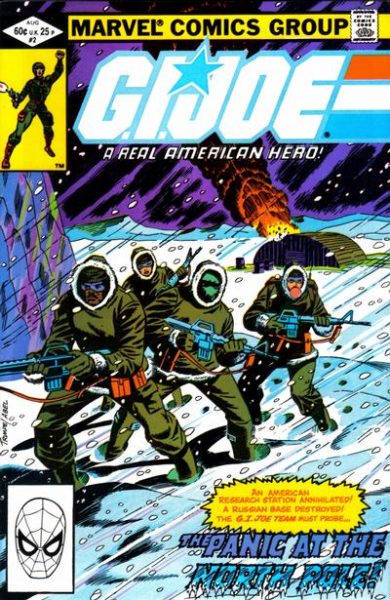
If I had to hazard a guess, backed up by literally no evidence whatsoever (though maybe I can peek through my fanzines from the period and see what sales on these were actually like) beyond my own proclivities as a comics retailer…I’d say that $1.50 price tag on a cartoon ‘n’ toy tie-in, two and half times the price of a standard comic, may have kept orders lower on the first issue. I mean, no matter how popular the property may have been at the time, there was no guarantee that would translate to comic sales of any note, and that high a price tag might have made the buying decision for anyone on the fence about it. And with that seeming barrier to entry, there was no reason to expect much repeat business for the second issue, even at the lower price.
Now please note that at no time am I saying the comic wouldn’t have had strong orders, or that it didn’t…just that the cover price may have kept them from being even stronger. And as it turned out, the first issue was very popular, enough so that there wasn’t enough of the second issue to go around, therefore low supply + high demand = $$$ for somebody. As a result, the price guide regularly had #2 listed at a higher price than #1.
But enough time has passed, with most early G.I. Joes being in less reliable availability at your local comics emporium, that the whole “lower print run” thing, if it ever actually was a thing, is of negligible importance in today’s market. #1 and #2 are both equally difficult to come across, and with the back issue market becoming increasingly focused on “number ones” and “key issues,” it’s not much of a surprise that prices for that first G.I. Joe have zipped on past those for the second.
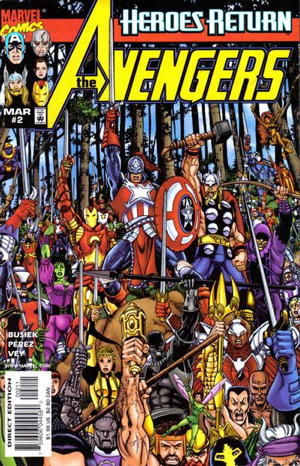
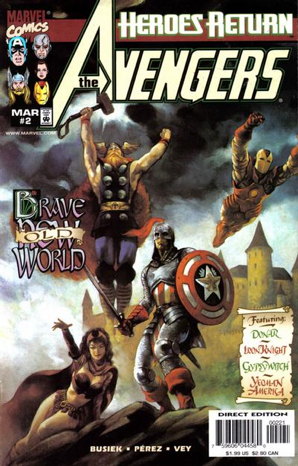
In the late 1990s, Marvel had a publishing strategy designed to counter the dip in orders new comic series usually had with the second issues of their runs. And that strategy was, as you’ve probably guessed if you’ve been reading the Monday posts on my site for the last few months, variant covers.
The deal was, retailers would order relatively high on a first issues, as that seemed like a relatively safe bet. Back in the days when you ordered a new series as if they were going to be ongoing series (and not for all intents and purposes a limited series), you placed numbers with the expectation that, should the series continue for a while…and there’s no reason why a comic featuring A-listers or even B+ listers wouldn’t…there would always be demand for that first issue. People like first issues. Kids want to own “Captain America #1.”
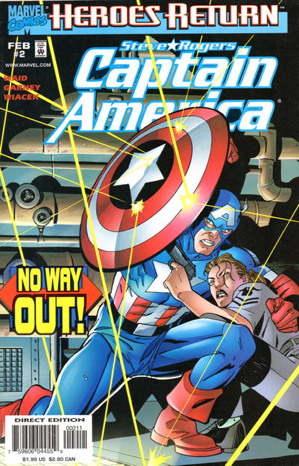
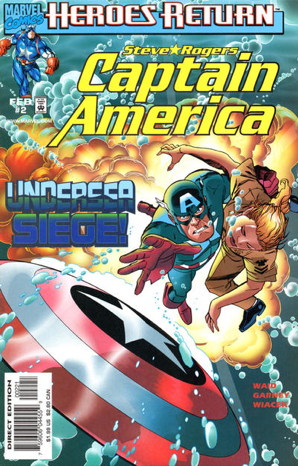
Of course, the market has changed, with new series now being launched, ended, and relaunched, flashing by like strobe lights and new #1s piling up for every title under the sun. That kid who wants to own Captain America #1 currently has a dozen or two to choose from.
Currently, the back issue sales window for a #1 issue is about as long as the new series lasts, then attention shifts to the back issues for whatever series featuring the same characters/concepts that succeeds it. But a couple of decades ago, retailers still pumped up those first issue orders.
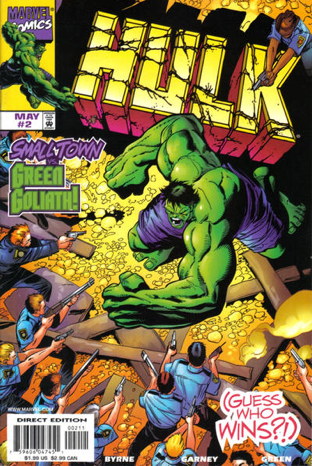
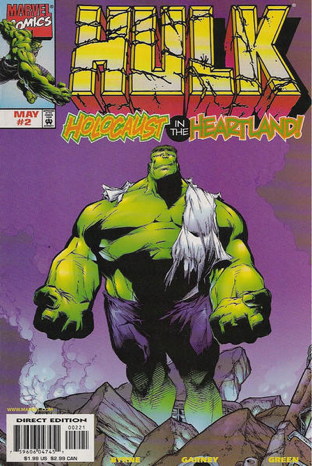
And then, to play it safe, order numbers would be pulled back a bit for that second issue. It was usually pretty safe to say (at least then) that many people would give a first issue of a new series a try to see if it was to their liking, or would just buy the first issue because, hey, it’s a first issue at cover price on the stands in front of me right now, I’ll buy a first issue, sure. And of the folks who bought that issue, only a certain percentage would come back for #2. As such, those second issue orders would drop, with the assumption that they’re not going to sell nearly the number they did on the debut issue. Then, by the time orders for #3 go in, hopefully you have an idea of actual realized sales on the first issue and you can adjust your numbers accordingly.
Of course, there’s always the problem — well, “problem” — of “what if it’s a hit?” What if you ordered what you thought was a sufficient number of #1s, but sold out due to the wild demand for that comic, and then #2 comes along and you don’t have nearly enough to go around? Suddenly #2 is a scarce commodity, and while you can raise your orders on later issues, will the demand continue if potential readers missed that second installment? All thoughts that you have to consider as you make that ordering decision.
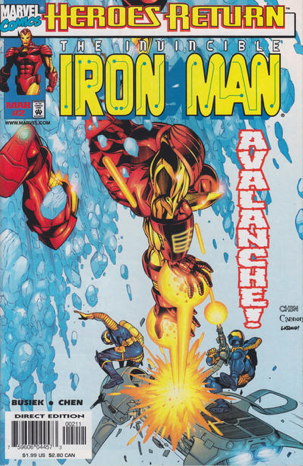
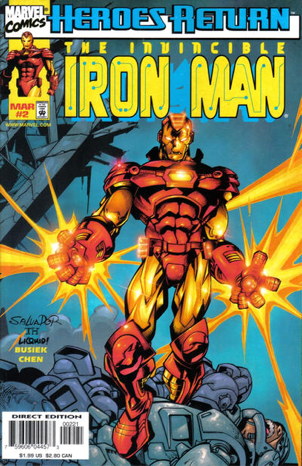
So, to help avoid that second issue dip, here comes Marvel with two covers for the #2s of all their newest ongoing series. “Why not just order what you were going to order anyway, but split the number between two covers?” As I talked about early on in this series of posts, the particular evil genius behind variant covers like this is the possibility of getting customers to double-dip. Some folks won’t be able to decide between the two covers offered, so “buy ’em both!” it is.
As I recall from my previous place of employment, we did order relatively high on the second issues, compared to what maybe we normally would have. And we did have some extra sales to folks seeking both covers. Persuing the Comichron sales charts for ’97-’98, it looks like there was still that dip on #2s, but perhaps it wasn’t as big a dip as it could have been. Comparing to other percentage drops from other titles around the same time, from other publishers, shows about an equal percentage of dropped orders…but orders on those first Marvel issues were perhaps unusually high, due to increased interest after the wrap-up then-recent “Image Comics creators back at Marvel” experiment with most of these properties.
Ultimately, it’s hard to say just exactly how well this strategy worked to keep plenty of second issues available for sale (and more importantly for the publisher, to get retailers to load up on ’em). As I recall, on most of the second issues, especially on titles like Captain America and Avengers, we nearly sold out on those #2s, so even with our slightly higher orders, perhaps the variant covers helped to bump up those sales.
Regardless of how much this variant cover scheme did or did not help, it’s pretty clear it’s Standard Operating Procedure on nearly everything Marvel and DC publish today. Though I don’t see nearly as many people double-dipping on the regular and the variant as I used to. At up to $6.99 for that stiff cover variant DC provides, or the boggling array of variants Marvel can release for any given comic for any reason…it’s not a surprise. Not that there aren’t folks out there trying to get all those variants…I’ve got a few at my shop! But that multiple cover strategy is more squarely focused on the retailer trying to juggle his numbers every month. At least, that’s what it feels like to me as I’m hunched over the order forms.
So this installment in my ongoing variant cover-age is going to be slightly less involved than previous ones, because 1) hey, I could use a small break, and 2) I came across something neat while processing some comics and thought I’d discuss it here.
Last week, I told you about that sizable batch of 1960s comics I’d acquired. In said batch were a few Gold Key Lone Rangers and one really beat up early 1950s Dell Lone Ranger. As I was pricing these, I noticed something in the price guide that I don’t think I’d ever noticed before, given the relative scarcity of Dell Lone Rangers that have passed my way.
For issue #37 of the Dell run (alas, not the one I got in this collection), there was a note stating that not only was this the last issue to contain the newspaper reprints that comprised the previous issues, but this was also the issue where the Lone Ranger gets some newly-colored togs. Instead of the red shirt in which he was normally clad, he was to have a blue shirt in its stead. “New outfit” reads the Overstreet entry, and that very outfit can be seen in all its glory in the wondefully painted cover for that issue:
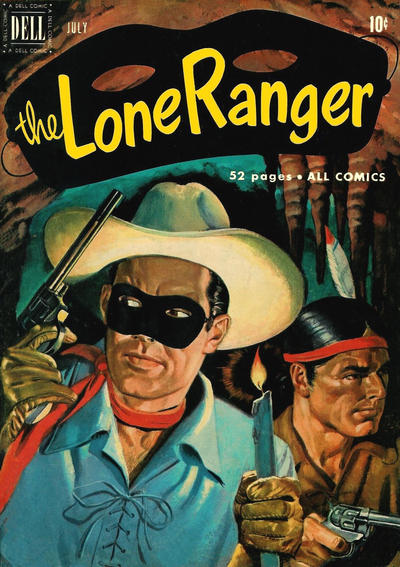
But wait! According to the guide, a few copies got printed with the red outfit, both on the cover and inside, as apparently somewhere along the line word didn’t get to the right people that Mr. Ranger was to have a fashion change.
The cover for that version (liberated, as was the previous image, from the invaluable Grand Comics Database) looks a little something like this:
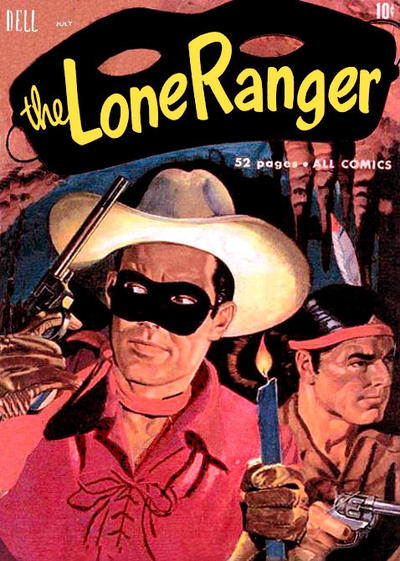
Now, I have no idea how many were printed (Overstreet calls it “rare”) or if they were just mixed in with the regular stock and distributed to newsstands, or just kept in the office and maybe handed out to employees.
The GCD’s specific entry for the red shirt variant has this to say:
“The SCOOP website reports ‘Noted collector Harry Thomas of Sweetwater, TN, however, has pointed out that there are still a precious few issues of The Lone Ranger #37 that may’ve gotten printed in the transition still feature him in a red shirt.'”
…which makes it sound like nobody’s quite sure if red-shirt variants made it out into the wild by whatever method.
I can’t seem to find any for sale, and I can’t log into the CGC “Census” portal to see if anyone’s put one into one of those plastic slabs. (If any of you have a membership there and can check, I’d appreciate it and update this post accordingly.) Any other sites with pictures of the red shirt cover appear to be using the same pic as the GCD entry (which (cough) me too).
It’s got me wondering if this version of the comic actually exists in the wild. Like, the story about the misprinting got out there, but somehow not the comics themselves. Now, the Overstreet Price Guide does have price listings for it, which theoretically should come from retailer sales reports of an actual item. And GCD does have that pic, which I suppose someone could’ve have Photoshopped from the original to make an approximation of the variant, to which I almost asked “but why would they?” until I remembered “why does anyone do anything on the Internet?” Anyway, that red shirt cover does have an overall…reddish/pinkish tinge, which makes me wonder.
But I don’t think that’s what happened. It could just be genuinely rare…it’s out there, somewhere, hiding in someone’s cardboard box out in the garage. And someone snapped our one and only oddly-colored picture of it and that’s all we got.
If you have more info on this variant, either by finding it for sale on some website I missed, or actually getting into the CGC database, please don’t be shy! Let me know and as I said, I’ll pass that info onto you!
So Sunday morning I was checking my email and noticed a message caught in the spam filter from someone asking about selling his stacks of 1960s comics. “NICE TRY, SPAM FILTER” I declare as I rescue the message and quickly respond with a “yes please, I would like to take a look at your ’60s comics.”
Now whenever someone says “I have old comics for sale” or “I have some original 1940s books I’m lookin’ to let go” a good portion of the time they turn up with, I don’t know, Marvel Team-Ups from 1983 or something. In general, I don’t hold my hopes up too high until I can actually see the comics in my hands. And even then I still don’t get my hopes up too high because there’s no telling if the seller “researched” prices online and decided that anything less than the $200 price some lunatic on Amazon put on this actually-valued-at-$4 comic would kill the deal.
As it turned out, the fella did have actually honest-to-Granny-Goodness 1960s comics, which were all actually his and purchased off the stands during his youth. Apparently he was cleaning out his mother’s house and discovered that she’d kept all these boxed away in the garage. So, you know, good on Mom for not throwing these away.
And I was able to make an offer that he was agreeable to, so I wrote him a check, and he walked out happy and I now have a new batch of funnybooks into which to dive. I did a small Twitter thread about it if you’d like to see some photographs, eh, he asked you knowingly.
“What’s all this got to do with variant covers?” I hear you asking, somehow, from all the way over here while you’re standing over there. As it turned out, this gentleman’s collection contained a lot of Dell and Gold Key comics, as a collection from this period is wont to have. He noticed, as he was making a list of his books, that there were several titles that carried over from Dell to Gold Key, and he wondered what exactly the deal was between the two companies, if one bought the other out or something similar.
Now luckily for me I’d read Mark Evanier’s explanation of the relationship between the two companies/imprints. Granted it was a while back, so I double-checked this evening to make sure I was at least partially correct and I was close enough for horseshoes. (Very shortly, a company, Western Printing, generated content that Dell published and distributed, until eventually Dell and Western split and Western started publishing the content themselves under the name “Gold Key” — seriously, read Evanier’s article).
“Still not anything about variants,” you sez. While some Dell and Gold Key had variant covers (differing back covers, price variants, etc.) my focus here is going to be on Whitman.
“Oh, now what’s Whitman?” you ask, and frankly you’re asking too many questions. But here, Whitman was an imprint used by Western for, among other things, comics distributed, usually in three-packs, to toy stores, department stores, that sort of thing…in general, non-newsstand distribution. While the “Gold Key” log would appear on copies distributed as normal periodicals:
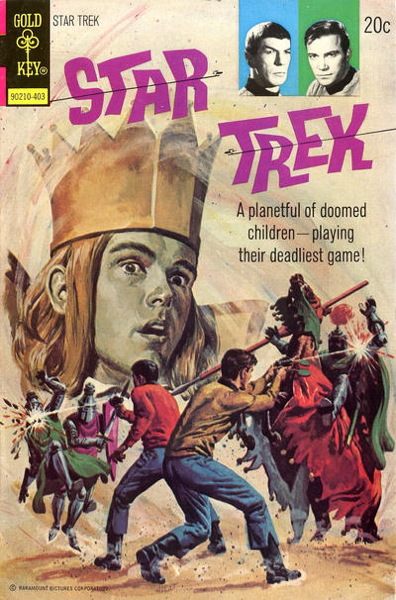
…the copies appearing in 3-packs would have the Whitman logo
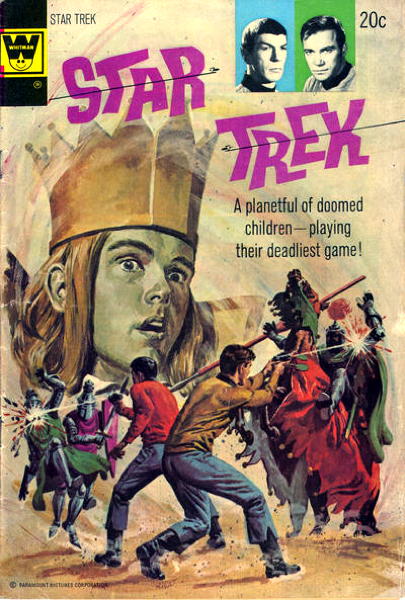
I presume at least one of the reasons was to prevent unscrupulous retailers attempting to get stripped cover returns using non-newsstand copies, though I’m not sure if the timeliness of the 3-pack releases would have allowed for getting copies back in the alloted return window for each issue anyway.
This dual-distribution resulted in several of Western’s releases having Whitman and Gold Key variants. And not just Western’s books…they also redistributed DC Comics into similar 3-packs, all with Whitman logo rebranding. For example, here’s a comic I remember having in a Whitman edition as a kid, Superman #327. Here’s the regular cover:
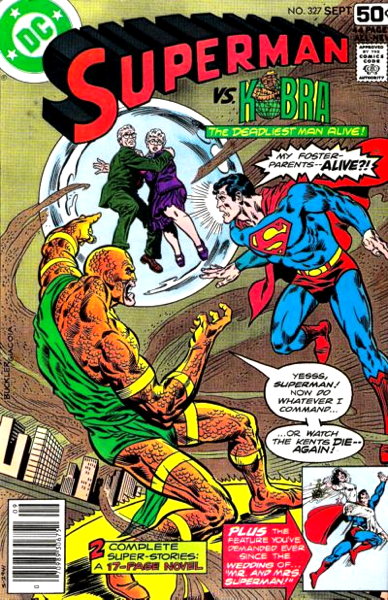
…and here’s the one with “Whitman” just slathered all over it:
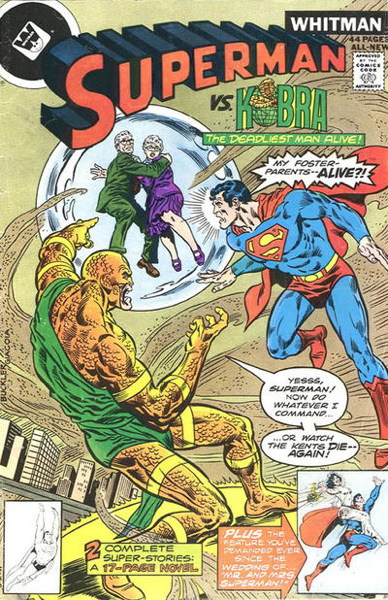
And of course there were Marvel Whitman variants, such as the Star Wars issues distributed in 3-packs:
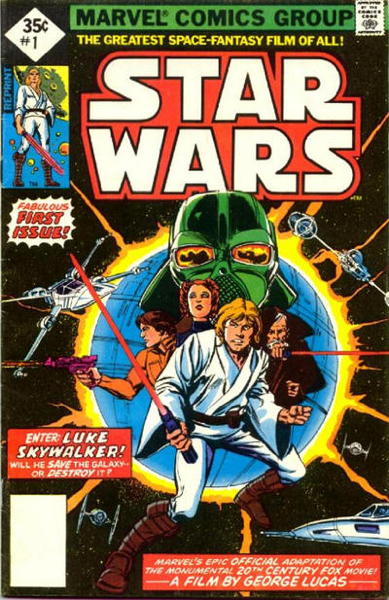
…but not with the Whitman logo. This was how I got the first six issues of Star Wars, via the 3-packs in Toys ‘R’ Us. (I think I got at least one pack of three later issues of the series from there as well.) Not sure why there was no Whitman logo on these.
Outside the 3-packs, there were Whitman variants of some of Marvel and DC’s oversized treasury editions, such as Marvel Special Edition #1:
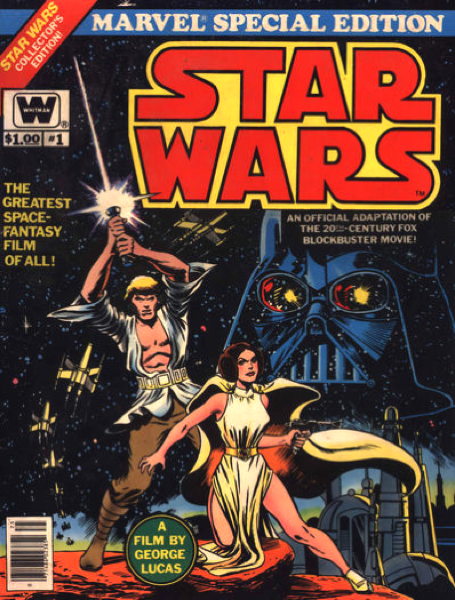
…and of course All-New Collectors’ Edition #C-56:
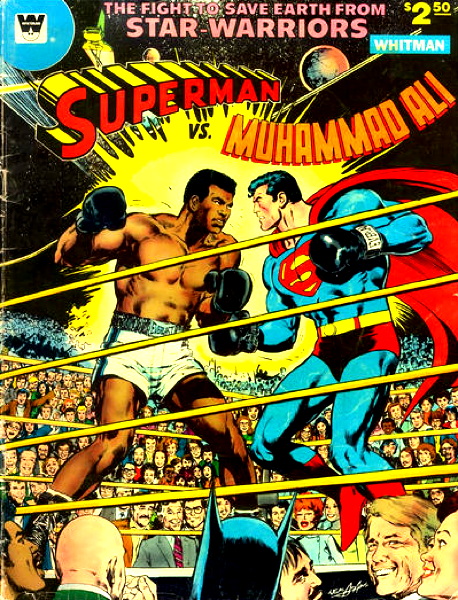
…presumably produced again for outside-newsstand distribution. (I can tell you my Whitman Superman Vs. Muhammad Ali copy came new distributed through direct-to-schools book sales.)
Now I may be a little fuzzy on the details regarding production and distribution of these books, but ultimately these variant editions do exist. And, for a long time I noticed during my early years in comics retail resistance to purchasing Whitman editions when there were regular editions of the comics to be had. (It should be noted that not every Whitman comic, especially with properties controlled by Western, had a “regular logo” cover, particularly in the late ’70s/early ’80s. And some issues were only distributed in 3-packs with Whitman logos.)
That resistance has gone away, unsurprisingly, but it predates the current panic over “nouveau hot” comics of late. Granted, the recent speculation market has only aggravated things (a search online for “Whitman variants” sure brings up a lot of people happy to tell you how rare and hot they are). However, I do have to admit they are much harder to find now, and they are alternate editions, so I must reluctantly accept that not everything in the comics market now is not absolutely 100% the same as it was when I started over three decades ago. [Insert clip of Garth from Wayne’s World declaring “we fear change” here.]
I am reminded of a two-or-three pack of Heavy Metal and a Warren mag or two that I bought when I was far too young to be buying it. Was this another Whitman repackaging, or some other company trying to unload excess copies? Perhaps an investigation for another time.
So when I was a kid, there were only two comics (that I recall anyway) that I purchased off the stands and were “double-covered” — in other words, an error in the manufacturing process attached a second cover attached over the first. One was this issue of Star Trek:
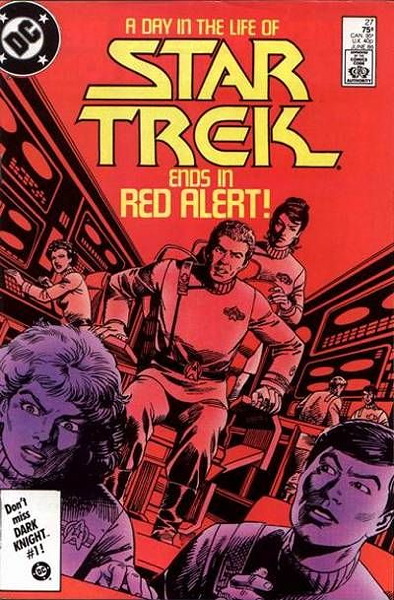
…and the other, this Batman Special:
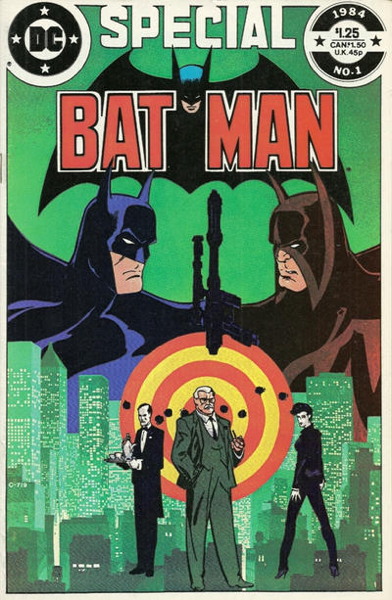
And being a Comic Book Collector, I of course removed those second covers and used them as decoration in my bedroom.
Now double-covers are sort of pushing the line a bit in my ongoing variant cover-age, as these aren’t usually created by publishers on purpose as sales incentives (titles like Lobo’s Back and Comic Book Guy: The Comic Book excepted, of course).
However, they are cover-related alterations to your standard comic book that can attract buyer attention. Technically an “error,” but not one that affects the intended usage of a comic (like missing or misordered pages). It’s a value add, in a way, and for collectors of older books it creates the possibility of finding a cover in good shape beneath the extra outer cover that protected it all these years.
I’ve heard tell of comics with three or four covers accidentally affixed to a standard comic book, but I would guess that too many extra covers slipping through to a single book would gum up the printing works. And speaking of which, as time has gone on, this type of error was decreased as technology improved. The modern double-cover is a rarity.
But on older comics…well, they’re still rare, but they’re out there. Amazingly, over the thousands upon thousands upon thousands of older comics I’ve processed for sale at the previous place of employment and at my own store, I can’t honestly remember the last time I found a double-cover. Which may be why it was such a surprise when a couple of days ago I came across an example on this copy of Daisy and Donald #2 from 1973:
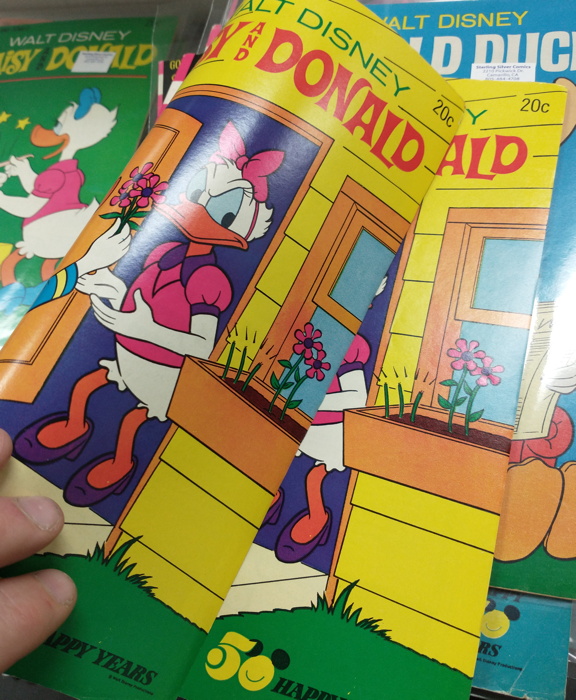
Well, that was pretty neat, thought I. Then, on Sunday, my former boss Ralph (who was at the shop helping me get more old comics processed) found this Flash #345 from 1985:
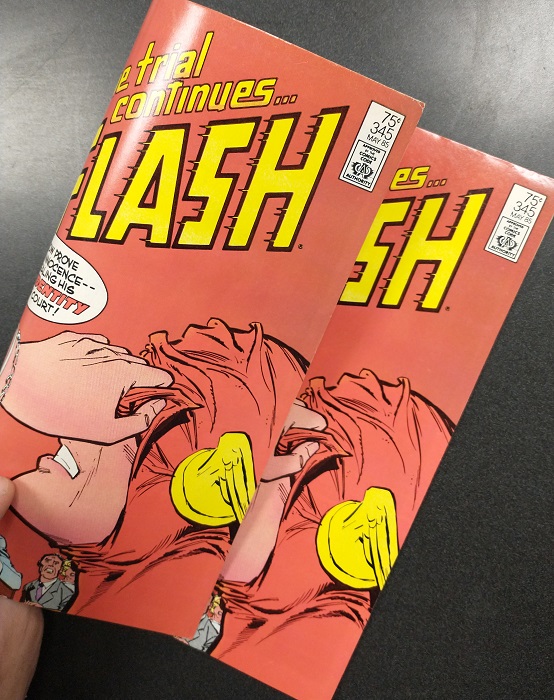
Now hopefully you can see why I had double-covers on the brain of late.
These comics 1) aren’t necessarily valuable or in huge demand in the first place, and 2) aren’t anywhere close to pristine condition and the difference in the shapes of the covers is relatively negligible, so I don’t know if the premium these comics will carry will be of any significance. However, given this crazy comics secondary market we’re existing in right now, I hesitate to say for sure what items such as these will go ultimately go for. Research is necessary, but again, the highly-mercurial nature of demand for collectibles in the presumably-latter-pandemic days may keep me from nailing down any price beyond “somewhat educated guess.”
Also, the double-covered Flash contains a Mark Jewelers ad bound inside:
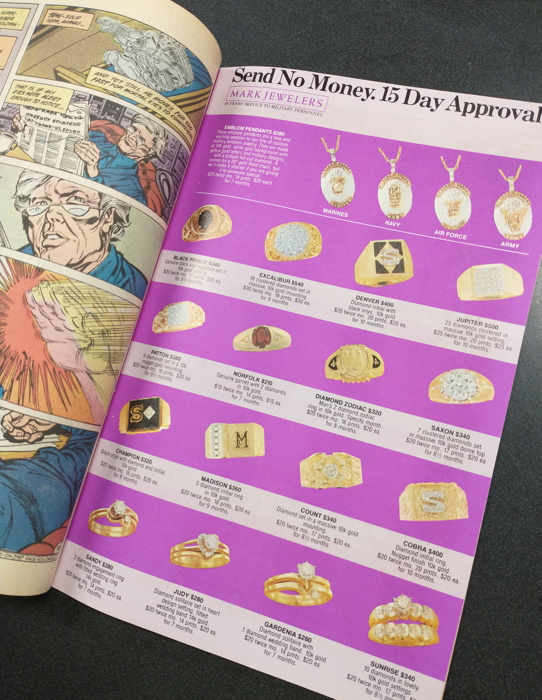
…which is yet a whole ‘nother thing. As Ralph said about this comic, “you probably have the only double-covered Flash #345 with a Mark Jewelers ad in existence!”
A quick Googling to kick off my research turned up a page on identifying fake double-covered comics, which is not a thing I’d ever considered. But I suppose it’s the sort of thing that probably seems like an easy thing to do (along with reinserting inserts like Mark Jewelers ads or trading cards into comics where they were removed, or never these in the first place). Plus, once again, we’re in a marketplace right now where people are desperate for collectible comics, so this sort of activity has probably only increased.
And yes, I’ve looked at eBay too, and prices for double-covered books don’t seem to be too far out of range with what I’d expect for many of the featured comics. Lots of other variables are involved (whether it’s slabbed and graded, is a “key” issue, is Golden Age or not), so further investigation is needed as to whether or not I’m charging $1,000 for that Daisy and Donald. (That Flash, however, is at least $2,000, easy.)
« Older Entries
Newer Entries »
























































